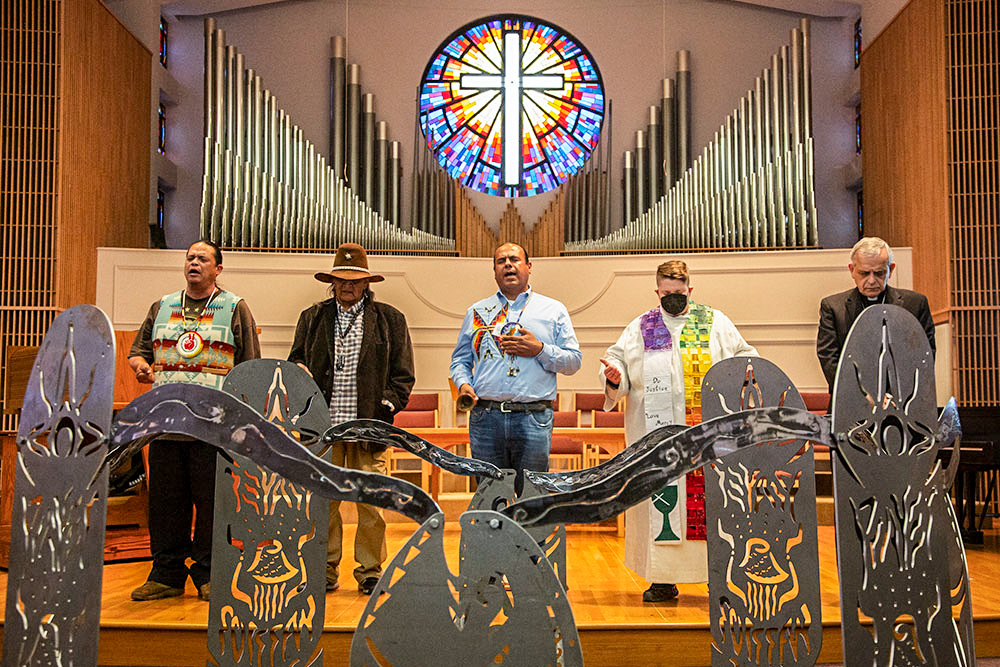
JoDe Goudy (center), vice-president Se’Si’Le’; the Rev. AC Churchill (second from right), executive director Earth Ministries/Washington Interfaith Power and Light; Seattle Auxiliary Bishop Eusebio Elizando (right); and other participants lead the community in prayer on Sept. 23, 2023, at an All Our Relations campaign event organized by Se’Si’Le’ in Olympia, Washington, at United Churches of Olympia. (Courtesy of the Nez Perce Tribe)
To many Native American tribes in the Columbia River watershed, which begins in British Columbia and flows through Montana, Idaho, Washington and Oregon, dams have prioritized shipping and hydroelectricity over the fishing rights guaranteed in their treaties. Decades of litigation demanding the removal of four dams on the lower Snake River to address critical habitat for endangered Chinook salmon has resulted in little more than Band-Aid fixes that don't go far enough.
About two years ago, Jay Julius W'tot Lhem and JoDe Goudy, leaders of the Indigenous nonprofit Se'Si'Le, approached the Washington state Catholic bishops for support in Se'Si'Le's All Our Relations campaign to advocate for dam removal, which they said will have the most consequential impact on the restoration of salmon populations in the watershed.
Julius said he began with a shared understanding of creation. If God created everything and it was good, what does it say about God if we are tinkering with an ecosystem? "We're saying in our opinion the Creator messed up on the river," he said. "If we say it's not true, we're in a huge stage of denial as people of faith as human beings."
He equated the justifications given to oppress and remove Native Americans from their lands — a reality he and his people still live with — with what is happening to the salmon. "We're doing it to God's creation. Are we just OK with it?" he said.
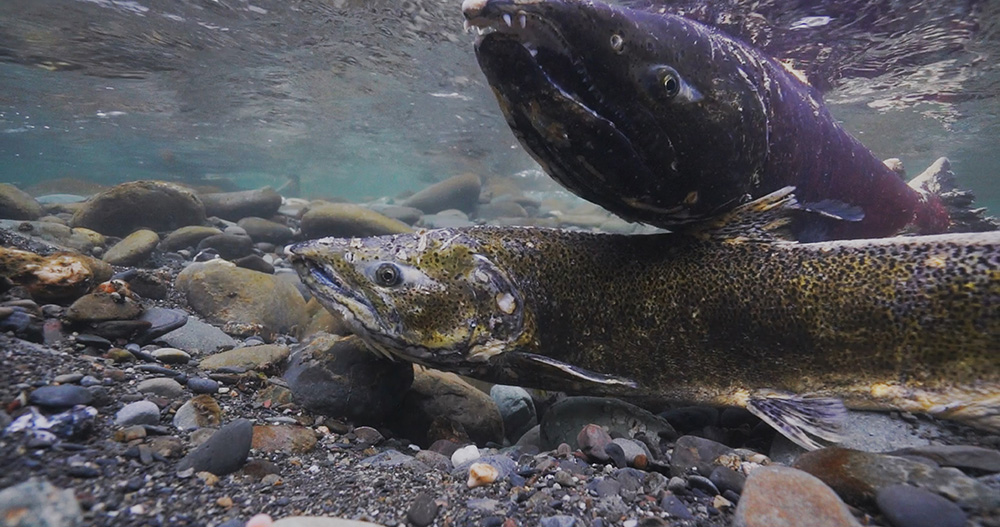
Adult salmon return to spawn in the streams and rivers of the Columbia River Basin where they hatched. (Courtesy of Shane Anderson, director of "Covenant of the Salmon People")
The bishops responded in October 2022 inviting Julius, the former chairman of the Lummi Nation, and Goudy, the former chairman of the Yakama Nation, to accept a statement read by Seattle Archbishop Paul Etienne. In the statement, the bishops asked policymakers to take steps to address the serious decline of salmon populations in the lower Snake River and ensure the ecosystem and its surrounding communities can thrive. Echoing Pope Francis' call in his 2015 encyclical Laudato Si', the statement emphasized the role of Indigenous leaders as principal dialogue partners in the work ahead.
Will Rutt, executive director of the Intercommunity Peace and Justice Center in Seattle, is turning the church's teaching into concrete action by listening and building relationships with Indigenous leaders.
Rutt said it's important to accurately evaluate the place of the church in this environmental justice work. "I don't think the faith community has been very strong on this," he said.
Recently, attention on the church's role in operating Indian boarding schools has illuminated a painful history for Native Americans, but the reckoning has yet to highlight its connection to environmental degradation, Rutt said. Faith communities aren't leading on this issue and should assume a learning posture, he said.
Yet, "amidst all of that difficult history I've experienced a lot of generosity and openness to partnering," he said.
Advertisement
Among those getting involved, St. Joseph Parish in Seattle held postcard-writing events after Masses last fall. The parish gathered more than 50 postcards to send to Washington state senators and the Biden administration urging for a dam removal decision to resolve the latest litigation process against the government for not protecting endangered salmon.
Chris Pinney, a Catholic and former biologist for the agency that operates the dams, offered his own brief in the lawsuit, documenting his career and testifying that the tech fixes that have been tried aren't doing enough to increase salmon populations. Recently retired, Pinney started at the Corps of Engineers in Walla Walla district nearly 30 years ago.
In December, the Biden-Harris administration announced its support of breaching the dams in a settlement, yet removal will take an act of Congress and could be decades away.
Pinney commented on the plan, "It's too little too late. ... We have to deal with power, transportation and irrigation before we can talk about the sacrifice of the fish and the tribes."
The settlement offers funding to develop renewable power sources, irrigation and transportation to replace the dam's current uses. It also funnels $300 million to fish restoration projects and hatcheries.
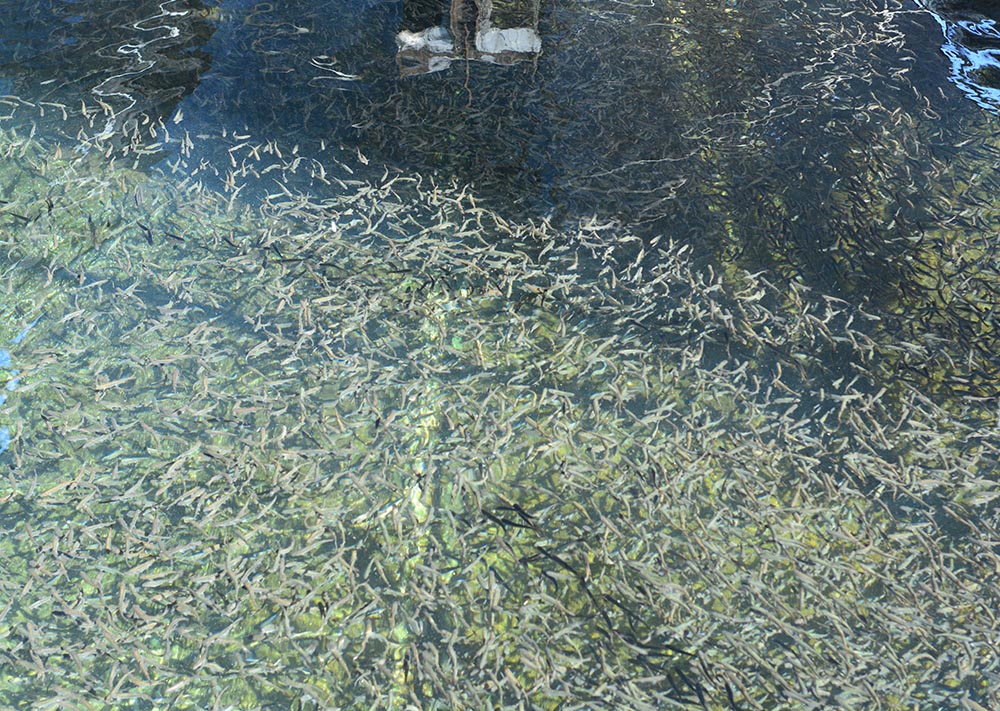
Fingerling Chinook salmon are seen at the Winthrop National Fish Hatchery in Winthrop, Washington, in 2023. (Wikimedia Commons/Joe Mabel)
Salmon hatcheries, many operated by local tribes, artificially propagate salmon to support wild populations. But hatcheries produce lower quality fish and they aren't expected to survive as well as wild fish in the face of a changing climate. While hatcheries serve their purpose, it isn't the solution that would have the most impact for salmon.
"We built a lot of Band-Aids," said Pinney, reflecting on his career. "Every Band-Aid had a consequence."
"There is no technology available, and it can't be developed through good engineering to really replace what the fish need," he said. Salmon need the wild river.
The history of the dams
In the 1950s, '60s and '70s, the U.S. Army Corps of Engineers built four dams on the lower Snake River, which joins the Columbia River on its path to the Pacific Ocean. The dams provide electricity in the region, barge transportation of agricultural products, and some infrastructure for farmland irrigation.
Since 1994, the federal government has lost five lawsuits, all ruling that the dams imperil salmon, which is a violation of the Endangered Species Act. Yet, so far, legal action has gained no traction on dam removal.
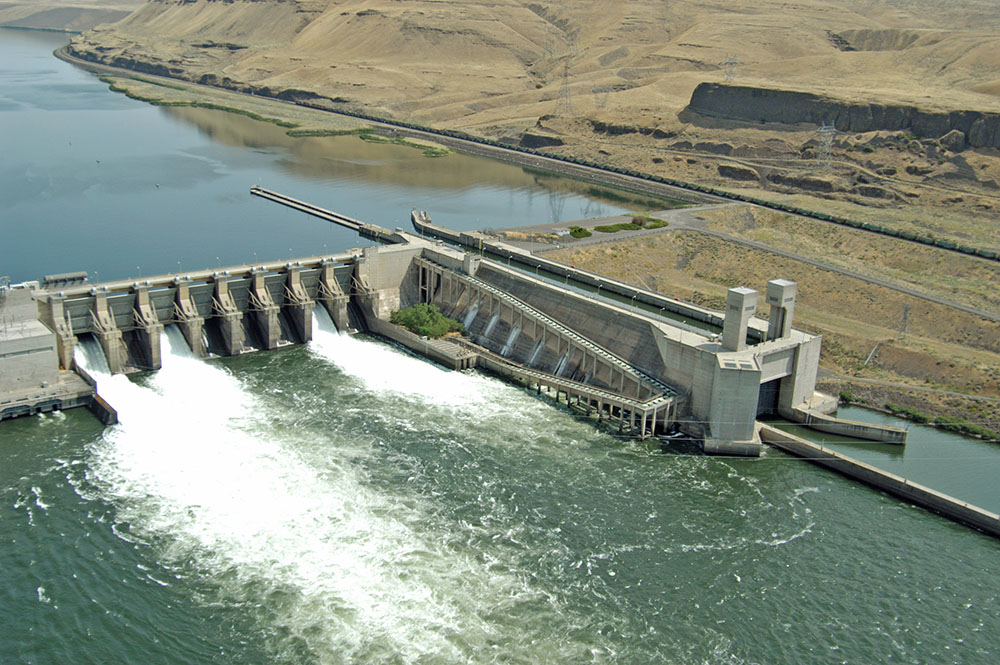
Lower Monumental Dam is one of four dams on the lower Snake River in Washington state. (Wikimedia Commons/Bonneville Power)
Once, 16 million to 20 million salmon returned up the Columbia annually. But overfishing by settler populations, timber harvests along streams, agriculture and, more recently, the construction of dams have contributed to decline in salmon populations.
Salmon are a way of life for tribes in the Columbia River basin — a part of their identity as a people.
"As Nimiipuu (Nez Perce) we are bound to the salmon and the rivers — these are our life sources. We will not allow extinction to be an option for the salmon, nor for us," said Nez Perce Tribal Chairman Shannon Wheeler in a press release.
"For too long we have seen the federal government try to do the minimum amount necessary to pass legal muster under the Endangered Species Act," said Warm Springs Tribal Council Chairman Jonathan Smith Sr. "This minimum effort approach has resulted in our fish populations limping along at depressed levels, oftentimes near-extinction and leaving us without enough salmon for our ceremonies, culture and subsistence."
Chinook salmon are a keystone species — a food source for the endangered southern resident orcas in the Puget Sound, as well as bears, seals and other wildlife.
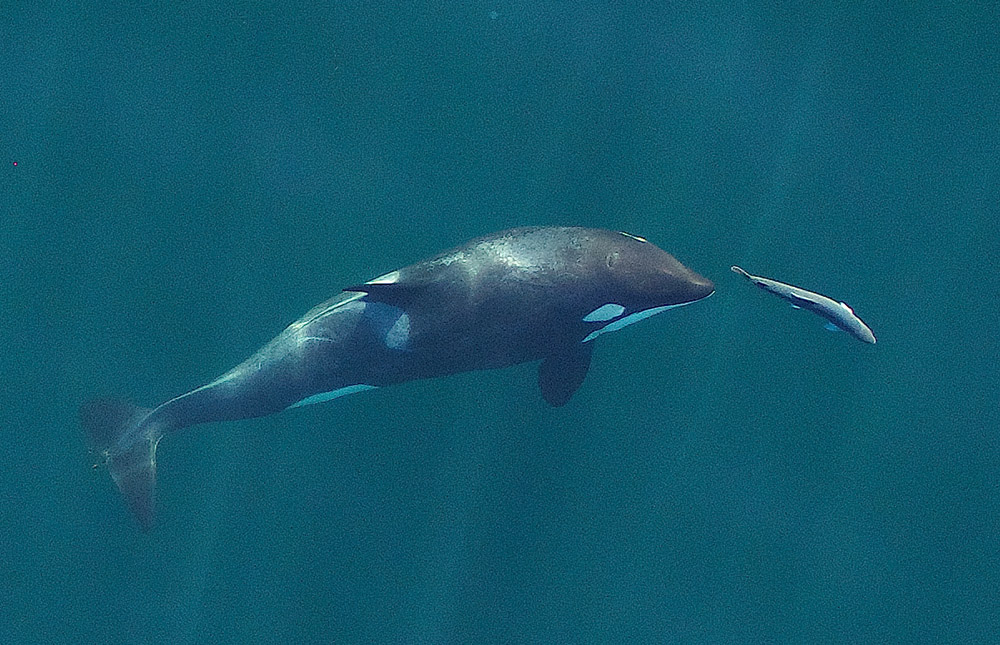
A young resident orca chases a Chinook salmon in the Salish Sea near San Juan Island, Washington, in September 2017. (Wikimedia Commons/Oregon State University)
The salmon spend their adult lives in the Pacific Ocean and breed in the rivers and streams of the Northwest. Swimming against the current, adult salmon traverse up fish ladders at eight major dams along the journey to the place of their birth to lay and fertilize eggs in the rocky gravel of cold, mountain streams. The reservoirs created by the dams become little more than warm lakes that can be toxic, slow fish down and make them vulnerable to predators.
For Native Americans, and the engaged Catholics who are now joining them, the struggle to protect the salmon population isn't over.
The route to faith-based advocacy
This isn't the first time the Washington bishops have spoken up about environmental concerns in the region. In 2001, the bishops released a 32-page pastoral letter on the Columbia River Watershed.
Though the letter treads carefully around perceived conflicts between various resource uses, it admits that the development of dams has harmed ecosystems and violates the treaty rights of Native peoples. It offers church teaching to reorient people toward care for the river system but doesn't name a position in the dam debate.
Catholics have struggled to connect the dams to their faith, said Rutt. He attributes this to the Doctrine of Discovery, which the Vatican repudiated last year.
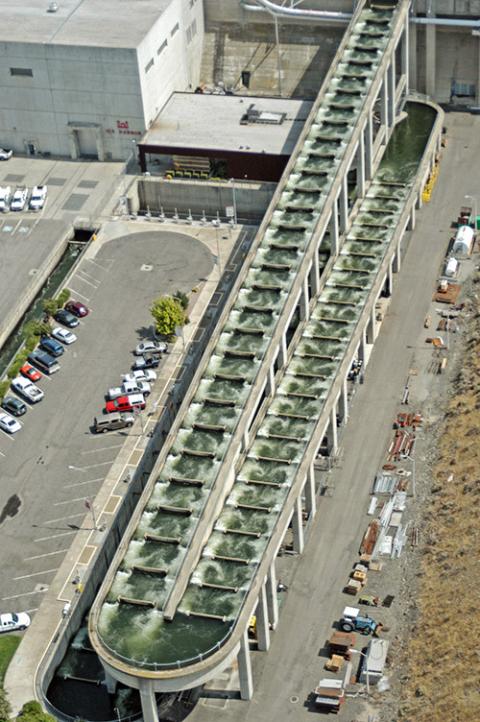
A fish ladder at Ice Harbor Dam on the lower Snake River in Washington (Wikimedia Commons/Bonneville Power)
Struggling to act, he said, is connected to "our perceived superiority to the Earth and Indigenous communities — that hierarchical relationship we've imposed on ourselves, the church. It's an identity crisis that we're encountering. We don't identify as part of creation. We identify as apart from creation."
Even when you refer to "creation care," Rutt said, it's identifying as a caregiver apart from creation.
"It's a colonial mentality. It's really hard to deconstruct that," he said. Coming to the advocacy work requires Catholic communities to redevelop an identity "without putting labor on those communities."
"What is my identity in relation to the land, my faith, God, my community, to colonialism and my family history that is integrated and implicit in that?" asked Rutt. "And as we come to terms with that, then we can begin to disrupt that cycle."
Said Julius, "We believe that we're just one species of millions of species on this planet, and common sense tells you if you were created last, there's something to be said about that. We've become the invasive species."
In regard to the advocacy work, Rutt said he moves with "openness and humility and an understanding that we're going to make mistakes, and then because we have good relations, people are going to tell us and help us get on the right path."
The trickiest balance is knowing that you have a role but "honing what's mine to do and what's not mine to do," he said.
In a parish setting, making clear connections between theology and colonialism is a challenge. "Those are pretty 10,000-foot-view words, and you talk about that from the pulpit and bulletin and the next thing you say is: 'Now write this postcard to Sen. Patty Murray,' " said Mark Petterson, who works on the climate justice committee at St. Joseph.
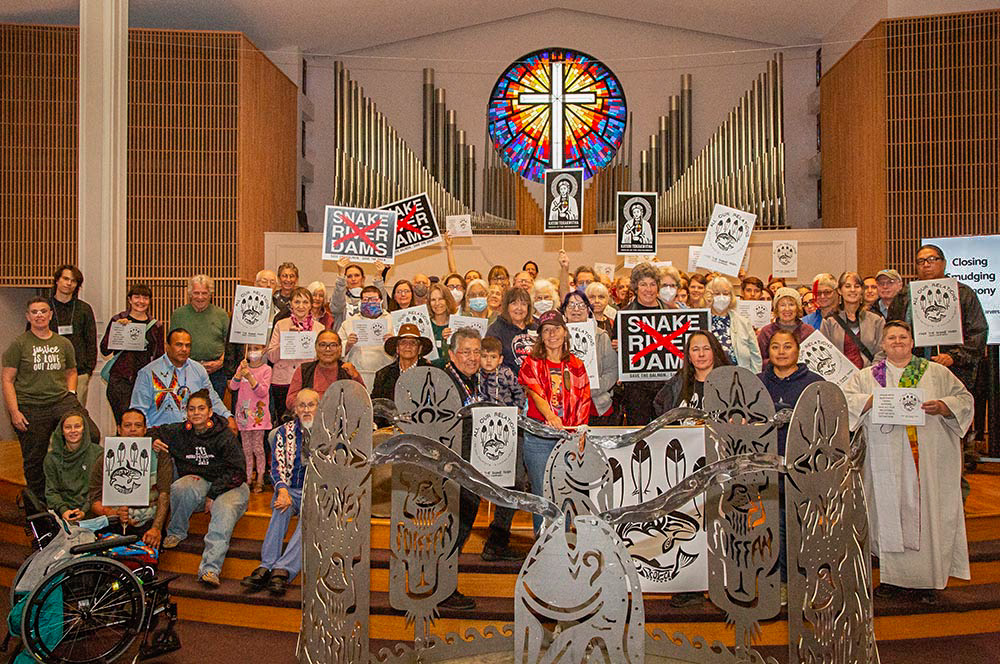
An All Our Relations event organized by Se’Si’Le’ at United Churches of Olympia in Olympia, Washington, Sept. 23, 2023, featured a hand-crafted steel sculpture created for the Snake River Campaign by Lummi Nation members A. Cyaltsa Finkbonner and master carver Jewell James. (Courtesy of the Nez Perce Tribe)
Parish members have eagerly learned from Laudato Si'. The challenge is in living it out, especially beyond an individualistic plan to green our own homes. Thus, to Petterson, Catholics supporting the All Our Relations campaign is a step in the right direction.
On the road ahead, the Intercommunity Peace and Justice Center, based in Seattle, will need to have generative discussions with Eastern Washington Catholics, who live on the reservoir and are not particularly in support of dam removal.
"There might inherently be things that people have to give up, but it's understandable given what has historically been given up [by Native Americans]," said Rutt. "Weighing that tension and walking with people through that is something that is really complex and something we need to do better."
In Walla Walla, where people will be most impacted by a dam removal, "I'm the rogue outplant in the Catholic community," Pinney said. He sees more engagement in Spokane around the Gonzaga University community or in Yakima in central Washington.
The quintessential realization people need to have might be the implications for all local communities, not just tribal ones. "What's at stake for the Northwest if a keystone species goes extinct? It's a domino effect, and it's going to be really bad," said Rutt.
In Pinney's view, understanding the relationship we all share with salmon and other species in the Columbia River Basin is what tribes offer — if people will listen.








